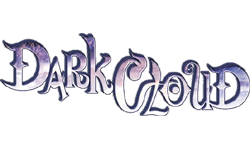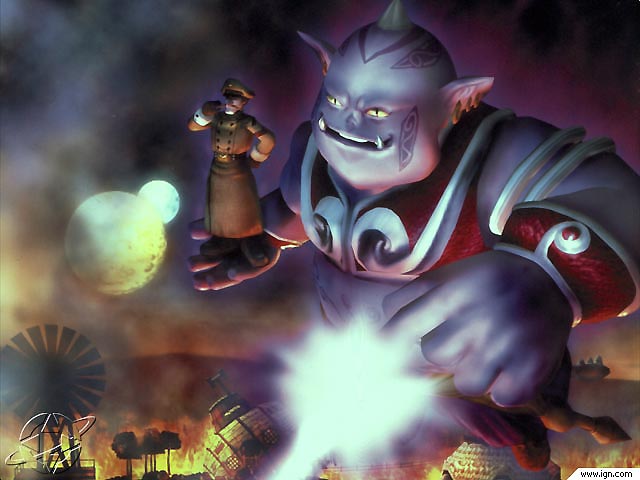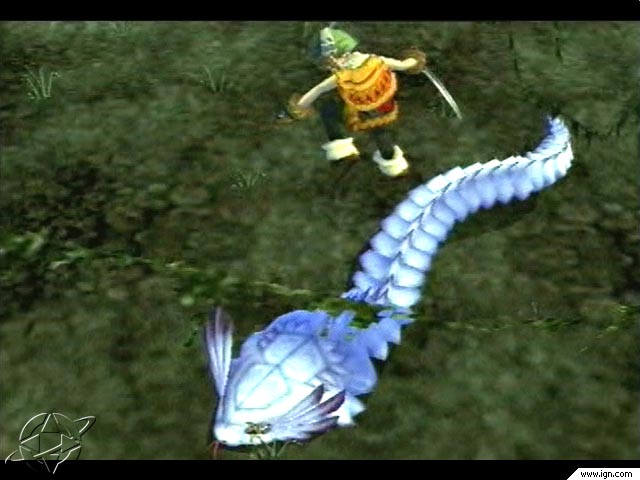|
|

|
BATTLE SYSTEM
|

|
INTERACTION
|

|
ORIGINALITY
|

|
STORY
|

|
MUSIC & SOUND
|

|
VISUALS
|

|
CHALLENGE
|
Medium Easy
|
COMPLETION TIME
|
25-45 Hours
|
|
OVERALL
3/5.0
|
Rating definitions
|
|
|
With the introduction line of RPGs for the PS2 being rather weak, RPGamers looked anxiously for the flood of solid title that the new console was supposed to herald. While the PS2 has certainly gone on to have an impressive library of RPGs across many different styles of gameplay, at first the pickings were quite lean. It wasn't long before those thirsting for a good RPG got to teethe on Dark Cloud. While it is not a stellar RPG, it stands the test of time relatively well. Dark Cloud puts together a fun creation system along with a solid soundtrack and decent battle system, though it is dragged down somewhat by the flaws in the battle system as well as a lukewarm translation.
Battles are reserved for dungeon areas, where a myriad set of enemies awaits in randomly generated levels. This is where Atla is collected to be used later in reconstructing the world. One character fights at a time, though swapping between is a snap. The main character and each of his allies have a base weapon they begin with, and can acquire other weapons over time via chests or purchases. Each weapon has a set amount of durability, and if a weapon gets to zero durability it shatters and disappears, with the exception of a character's base weapon which will simply become ineffective. To counter this, weapons can be repaired with powder at any time. This system would work just fine if two variables were not present: one, were there not several different types of creatures who consistently slice off a significant portion of endurance and two, were there not combo swings each character performs that cannot be stopped once started. Though characters do not level up, their weapons do, gaining ABS with every kill. Once a weapon reaches its max it can be levelled up, gaining more power. Plates can also be attatched to each weapon (from two to four, depending on the weapon) which will permanantely enhance the weapon after the upgrade. These plates have a variety of benefits, from more endurance or strength, to additional elemental damage, to increasing damage against a set of enemies like undead or plant. Weapons that have been upgraded five or more times can be turned into plates themselves to attatch to other weapons; while this permanately destroys the weapon it will give whatever it upgrades 60% of the stats it had before it was destroyed. Weapons can also class up by meeting specific requirements, such as having a certain combination of elements, and attack power. However, most weapon classes require multiple facets of the weapon to be strong.
 The Dark Genie!
The Dark Genie!
|
|
Enemies, as the usual spiel goes, are generally weak to one element or another and go down easier when a weapon has this element. Different characters have different type of weapons, and some are more effective against certain enemies; for example, the catgirl's slingshot makes defeating winged enemies a snap. In order to move onto the next floor, the group must find the key to the dungeon's exit and use it to escape, which is held by an enemy. Each dungeon's key is different. There are also obstacles in dungeons which require certain party members' skills, such as a switch that can only be hit with a heavy hammer. Between floors the group may choose to forge on, or go back to the surface to get items or set up new Atla parts. There are many floors to each dungeon, culminating in a boss fight; once this battle is cleared a new area will open up for the player to continue exploring. Ocassionally, the player will also run across duels, which are fought in a unique way. Buttons scroll across the screen such as arrows or the square/triangle/cross/circle buttons, and the player must hit them once they pass over the action window. The closer they get to the small, bright patch of the action window, the better they do in the fight.
The music does an excellent job of setting the mood and the sound effects are suitably background, though some are overused; the sound of some of the characters attacking gets a little tiring after a while, as their shouts or noises happen every time they attack. Thankfully, with the option to switch between characters on the fly this isn't a huge problem. These voicebits are far overshadowed by the excellent music found within. While the visuals aren't stunning and there's some little flubs like obvious rotation points on legs and arms, the graphics are done fairly well, especially considering this was one of the first titles made for the PS2. It's not perfect by any means but it certainly does the job and adds to the overall appeal of the game.
The difficulty in the game mostly lies in the fact that it is too easy to break weapons, often leaving the player frustrated and reaching for the reset button. As well, when required, new characters when acquired are not yet suitable to bring into dungeons at the same level they are found, meaning that to get them up to speed some backtracking to previous floors is usually required, which can be a turn off to those who race through games. On top of these problems, for some unfathomable reason the game designers also chose to throw in thirst, meaning that characters get thirsty as they travel along in the dungeon and require a drink either from springs inside the dungeon levels or from water-type items. Why this particular aspect was added is unclear, as it adds nothing to the gameplay. Despite these setbacks, the game can be inhaled for those who wish to rush through in as little as 25 hours; those that wish to stop and enjoy the scenery, as well as fiddle with the construction system, will find that their play can be extended upwards of 45 hours or thereabouts.
The interface is very well done. Navigating menus is simple and efficient, and recreating areas is fun. Each section has a slot shaped like an item and hints as to what it might be. Whenever a player is stumped or a spot is marked with a question mark, all the player has to do is query the inhabitant for what they wish to complete their restructured home and then add the appropriate items. The localization, however, is not always so clear. There are numerous problems cropping up from the Japanese translation such as r being used in the place of l, as well as some plain old typos. Had the translation been looked at more deeply these errors could have been easily flushed out and it is disappointing to see such silly mistakes in a game.
 Dueling A Snake
Dueling A Snake
|
|
The most enjoyable part of playing Dark Cloud is the creation system. As previously mentioned, Atla is acquired in dungeons and stored in an Atlamillia gem on the main character's hand. Once he return to the surface, these can then be pulled out and reassembled. Atla can contain houses, or people, or possessions, or simply items such as road and river. In addition, once people are returned to their homes they will have requests as to how they would like their restructured town to be set up. This could be as simple as being beside water, to intricate relationships between numerous villagers who want to live close to, or far away from, each other. Getting everyone satisfied can be a time consuming process but is well worth the effort, as completing an area will net the player a unique item. This feature gives the game a lot of originality, and gives what would be just a flat dungeon crawl game a flowing and coherent storyline. As the party moves through different areas, why the tragedy that befell the world and forced everything into Atla is further explored and a reason why a certain mysterious character keeps popping up will also be finally solved. What the character may not learn from their adventures directly is often filled in by the Earth Faerie who aids the main character in his quest to restore the world's people and places.
While there are plenty of other superior games out nowadays given the amount of time that has passed since Dark Cloud's release, in the young ages of the PS2 this was as good as it got, and it really wasn't all that bad. For those looking for something different than the usual run of the mill, age is not a factor here. Level 5 took a nice idea and turned it into a decent, if not solid, title. Even nowadays, it can still be enjoyed as a game that is unlike anything else, with perhaps the obvious exception of Dark Cloud 2. Though it does have its quirks, the good points of the game do tend to shine through, so those with patience should definitely look into this title if they have not already.
Review Archives
|









